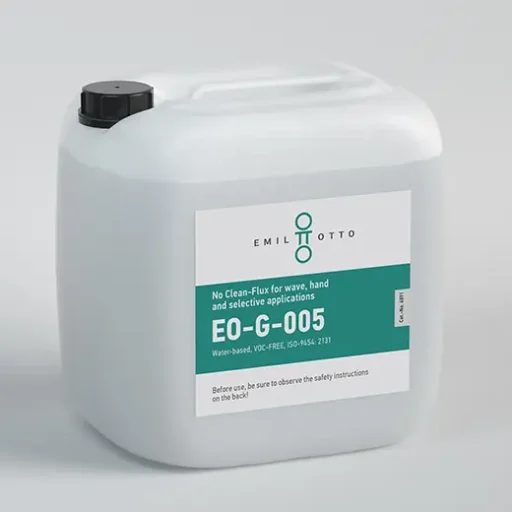No Clean-Flux, water-based
Di-carboxylic acids, VOC-free (WEEE/RoHS compliant)
Type ISO-9454: 2131 DIN EN 61190-1-1 (acc. J-STD004) (IEC ORM1)

| Appearance: | transparent, clear liquid |
| Hazardous goods: | No |
| VOC: | 0.0 % |
| Solids content: | 4.0 wt.-% |
| Acid number: | 28 – 35 mg KOH/g |
| Halogen-free: | No |
| Resiny: | No |
| Activators: | di-carboxylic acids, VOC-free |
| Solvents: | water-based |
| Flash point: | non-flammable |
| Available as concentrate: | No |
| Durability: | 12 months |
EO-G-005 was developed for use on wave soldering machines and has a relatively high activity despite the low solids content of only approx. 4 wt.%. The flux is applied by means of a spray fluxer; under certain circumstances, the flux can also be applied via brush fluxers.
It is recommended to test assemblies soldered with water-based fluxes, which are subsequently painted or encapsulated, for compatibility of the coating media with the flux residues beforehand. In addition to the suitability test according to DIN 61190-1-1, the flux also passes our internal “EO in-house standard EO-STV-2016-02-01, which is based on the rapid test procedure for selective, immersion and manual soldering fluxes according to Fraunhofer (ZVE). This means that the flux residues of the EO-G-005 after selective soldering can be assessed as significantly less critical and non-corrosive than those of conventional fluxes for wave soldering.
Recommendations for processing:
Foam fluxes: Not recommended
Spray fluxing: If dosing is possible, first adjust the flux quantity to 10 – 20 ml/min, observe the even flux distribution on the PCB (test with thermal paper if necessary) and then correct to the optimum quantity.
Preheating: For “simple” PCBs a preheating temperature of 80 – 110 °C is recommended, for “more complex” PCBs 110 – 130 °C on the top side of the PCB. It can be used in both leaded and lead-free solder systems.